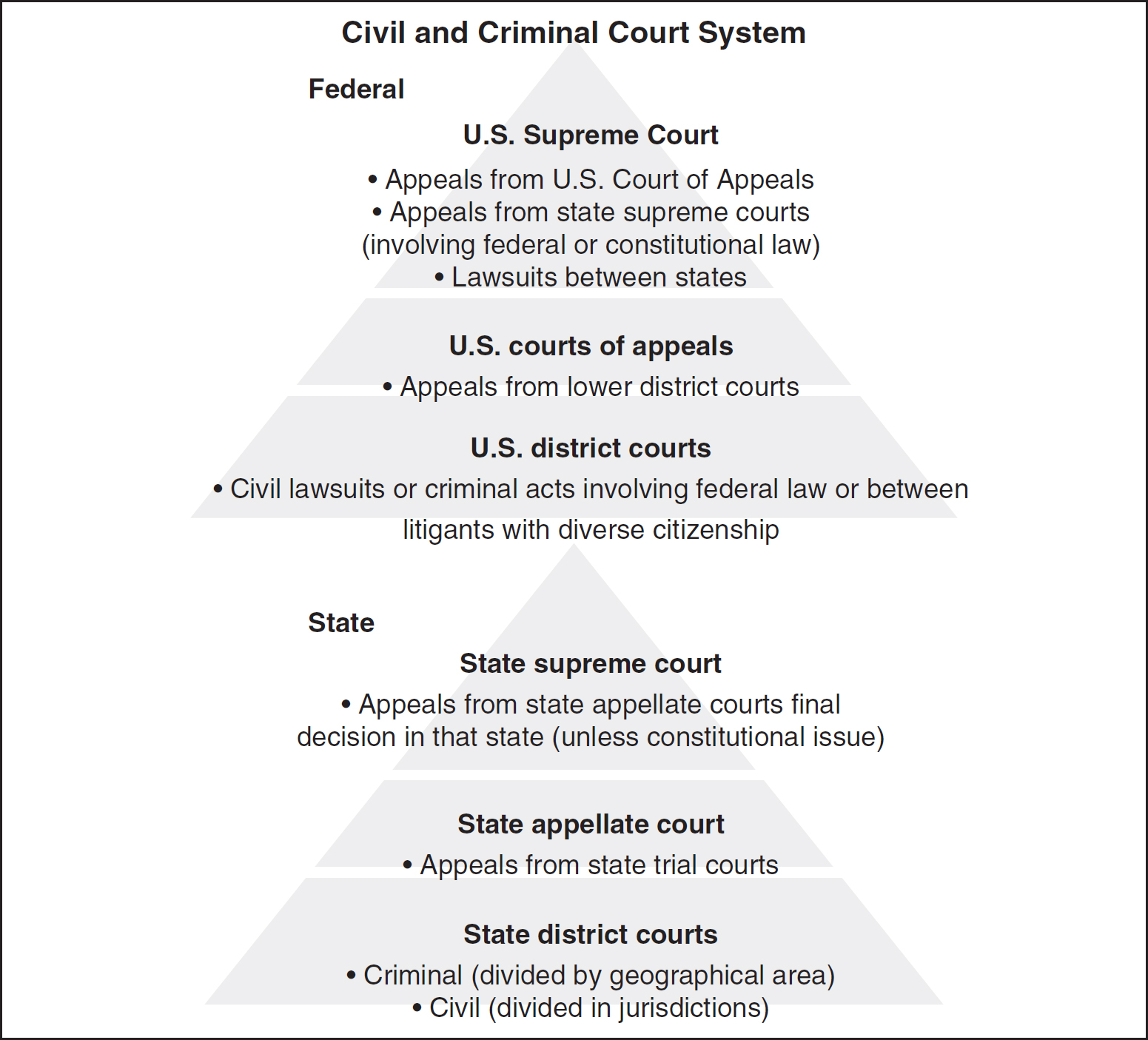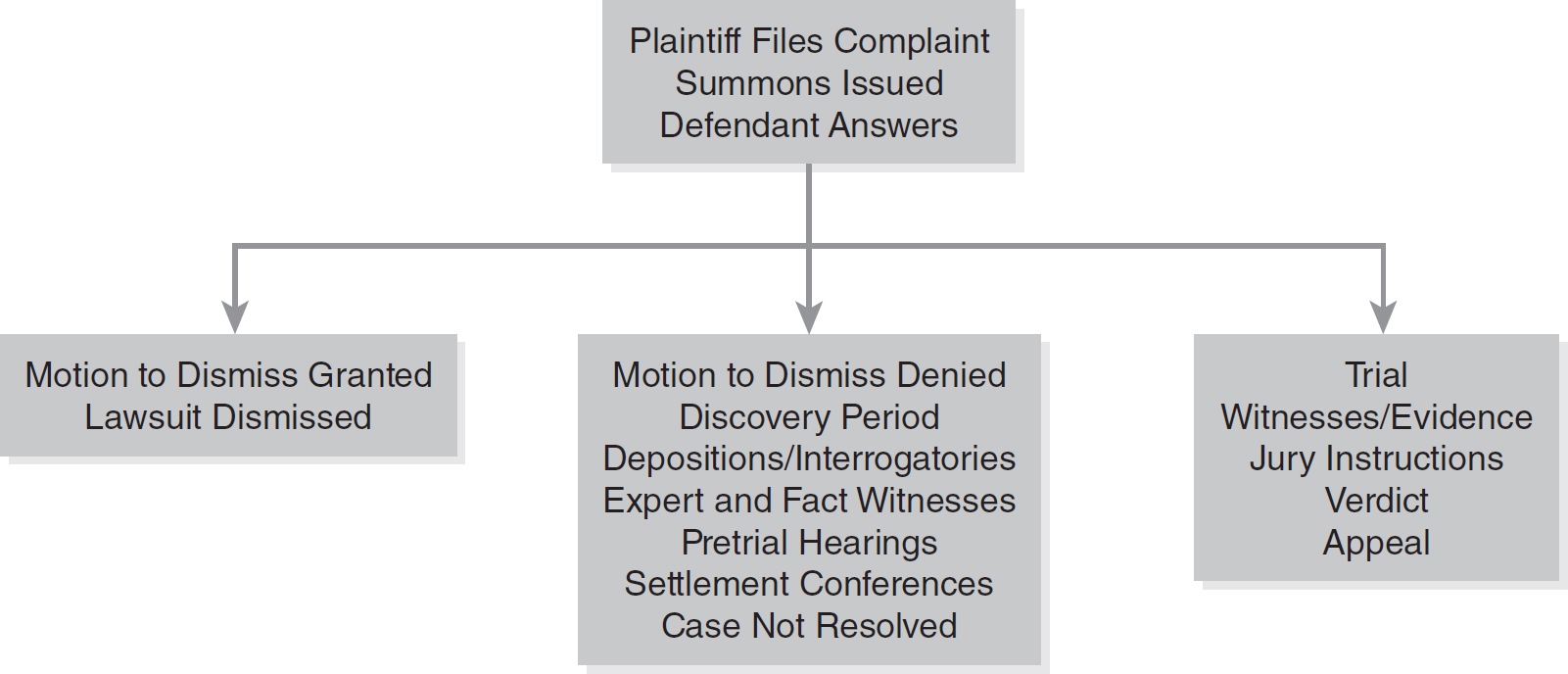Figure 1-1 Tier like system of courts.

© Jones & Bartlett Learning
Law has been defined as the formalization of a body of rules of action or conduct prescribed that is enforced by binding legal authority or as the sum total of rules and regulations by which society is governed. Because law reflects society's values, it is by definition an ever-changing and evolving concept subject to modification. The law reflects the will of the people as represented by legislative or judicial bodies (almost all of whom are elected) that enact the law or interpret the law.
Constitutional law is the organizational framework of a system of laws or principles that govern a nation, system, corporation, or other organization. It forms the basis of how that entity will be governed. The U.S. Constitution (and its amendments) is the supreme law of the United States and sets forth the general organization of the government and the powers and limitations of the federal government. The best known limitations on the powers of the government are the first 10 amendments, known as the Bill of Rights. These incorporate such concepts as free speech, freedom of religion, and the right not to be deprived of life, liberty, or the pursuit of happiness without due process of law. Any rights not expressly granted to the federal government are reserved to the states.
Also established by the U.S. Constitution are the three branches of government: executive, judicial, and legislative. The executive branch administers and enforces law, while the legislative branch enacts law, and the judicial branch enforces law through the process of adjudication. These three branches serve as a system of checks and balances, with powers separated and distributed among them.
Individual states have constitutions and are also an important source of legal rights. If there is a conflict between federal and state law, the federal law would take precedence as the supreme law. The Supreme Court can also declare that laws are invalid and unconstitutional when they are not consistent with the constitution (Marbury v. Madison, 1803).
Enactments by the legislative branches of government are known as statutes, the written laws that are “on the books” and codified or available in writing. Examples are the U.S. code that contains federal statutes, state statutes (such as the Connecticut General Statutes), and ordinances passed by city or municipal government representatives. The nurse practice act (NPA) is an example of a statutory law that is available for review in the written statutes of each state.
Administrative agencies (e.g., National Labor Relations Board, state board of nursing) are empowered by legislative bodies to implement a certain area of law called administrative law. The administrative agency has delegated power through a statute to make administrative rules and regulations and to adjudicate disputes within the area of delegated power. Decisions by these agencies are subject to judicial review on a very limited basis, and the agency is considered to be the expert decision maker in its area of expertise. Administrative rules, regulations, and decisions are subject to administrative procedure acts, which also govern their activities.
Attorney generals' opinions are another source of administrative law. An attorney general may be asked to render an opinion related to an important aspect of administrative law. This will stand as binding until it is overruled by a specific statute, regulation, or court order. These opinions serve as an important source of guidance in interpreting statutory or common law.
The common law, or case law, is the result of judicial decisions made from disputes that arise and are decided in courts of law. Case law is an important source of guidance for others who may be in similar circumstances because it serves as legal precedent in the jurisdiction where the decision was made. Even though case law is not precedent or binding for other jurisdictions, courts often look to case law for guidance in similar situations. Important case law (usually that which has been appealed) is reported in case law books, which are available at law libraries or online by accessing legal databases.
Courts in the federal, state, and municipal systems are organized in a tier like structure (see Figure 1-1). The lowest level is the trial court where cases are first heard. The second level is the intermediate court, or court of appeals, where the case is taken if one of the parties is not satisfied with the outcome in the trial court. The highest level in the system, the Supreme Court, often makes the final decision, but higher courts do not automatically take all cases that seek an appeal. The trial court for the federal system is called the federal district court, and the intermediate courts are divided into circuits that cover several states. It is important to know in which court a case is decided to determine if it is applicable as precedent in a subsequent case.
Many special branches of trial courts have a particular area of authority or jurisdiction (e.g., probate court often is the designated court for decisions related to the competency of patients, whereas family court may handle the termination of parental rights).
Procedural laws (e.g., evidence and jurisdictional laws) prescribe the manner in which rights and responsibilities are exercised and enforced in court. They provide the form and manner of conducting judicial business before the court. Substantive laws (contract, criminal, and civil laws) define and give rights that the court administers.
The due process clause in the 5th and 14th amendments provides citizens with procedural and substantive due process. Procedural due process applies when a citizen has been deprived of a life, liberty, or property interest. The person is entitled to be heard in a proceeding (hearing right) and must be notified of such a right before the deprivation (notice right). Substantive due process requires fair legislation that should be reasonable in context as well as application. No one should be unreasonably or arbitrarily deprived of life, liberty, or property.
When parties disagree or when someone wants to assert an individual right, a lawsuit may be filed to resolve the issues (see Figure 1-2). The purpose of bringing a lawsuit is to resolve the matter at hand in an orderly and fair manner. The person who brings the lawsuit, or plaintiff, files a complaint outlining allegations against one or more defendants. A summons is issued, and the complaint is served upon the defendants, who must answer the allegations set forth in the complaint. Failure to file and answer the complaint in a timely fashion may result in a default judgment in favor of the plaintiff. Defendants may answer the complaint with counterclaims of their own and may deny the allegations. Both the plaintiff and the defendant usually retain an attorney to represent them in the legal action.
Figure 1-2 Anatomy of a lawsuit.

© Jones & Bartlett Learning
Nurses are sometimes involved as defendants in lawsuits by a patient/plaintiff. The patient may allege malpractice or negligence by the nurse during a professional relationship. The hospital or agency that employs nurses and other caregivers, such as physicians, is often named in the same lawsuit as party defendants. This results in multiple attorneys and insurance companies being involved in the same proceeding. Allegations against each of these parties must be proven for the plaintiff to prevail against that party. Plaintiffs are increasingly naming multiple defendants, including nurses, to improve their chances of a full recovery.
In other situations, the nurse may be the plaintiff party who is seeking reinstatement following an alleged wrongful discharge by the defendant employer. Although the nurse may have malpractice insurance to cover expenses related to defending a malpractice claim, costs of litigation are most often the individual nurse's responsibility in other types of legal actions.
A period of discovery usually follows the defendant's answer, during which the parties gather information and make official statements about the facts surrounding the incident in question. Depositions, or sworn statements, may be made in the presence of a court reporter, or written interrogatories may be answered, both of which preserve the evidence for later use at trial. During any of the discovery proceedings, either party may file a motion with the court for a summary judgment in their favor. If granted, the lawsuit is ended, unless the losing party seeks an appeal of that order.
One of the purposes of discovery is to reveal what facts the witnesses and parties know regarding the claim, thus “discovering” the facts that will be admitted at trial to resolve the case. By completing this less formal discovery process before the trial begins, the parties may reach a settlement, or a party may withdraw the lawsuit if it is anticipated that the case cannot be proven. Pretrial hearings and settlement conferences precede the actual trial.
If the case continues, there is a trial where either a judge or jury will hear the case and make a decision, depending on the nature of the proceedings. Various motions can be made by either party during the trial, including a motion to dismiss the action. Witnesses testify and are examined and cross-examined by the opposing party's attorney, and other evidence is presented at the trial. The plaintiff's case is presented first, followed by the defendant's case. Either party may request a motion for dismissal or a directed verdict based on a lack of evidence presented by the opposing party.
The jury is instructed by the judge on the law related to the case, and then the jury deliberates and reviews the case. Finally, a verdict or outcome of the case is reached, and the judgment is executed. Damages are usually awarded as part of the judgment and are most often monetary damages, but other remedies may be ordered, such as specific performance of a contract. The losing party may still make a motion for a judgment notwithstanding the verdict or take a later appeal of the judgment.
Sometimes a lawsuit can be avoided if the parties agree to use other methods to settle a dispute or if this right arises, for example, from a contract. One process is to use a mediator or impartial party who meets with the parties and attempts to have each understand the other party's views. Thus, a voluntary settlement or mediation of the matter may result, often at a considerable cost savings compared to having a lawsuit proceed.
Another method is an arbitration proceeding where an arbitrator is selected by the parties, and a legally binding decision is offered by the arbitrator. The arbitrator, a neutral party who is sometimes an attorney, hears both sides of the dispute in a more informal proceeding where witnesses can be heard and questioned. There is no court reporter to make a formal recording of the proceeding. Both parties agree before the arbitration hearing that the arbitrator's judgment will be legally binding. Increasingly, parties are using alternative dispute resolution processes to avoid the costs and length of a lawsuit. There are attorneys and others who specialize in this area of practice.


